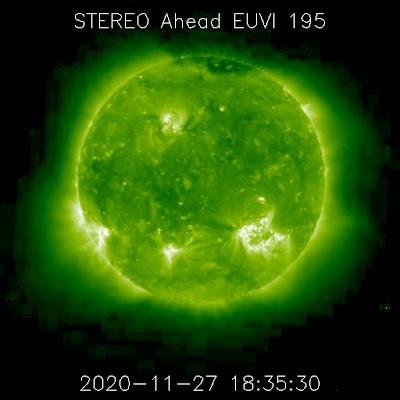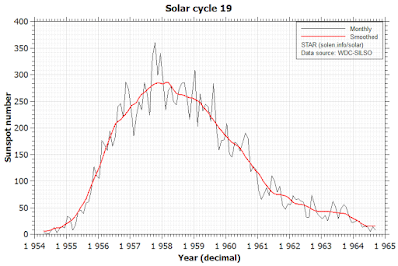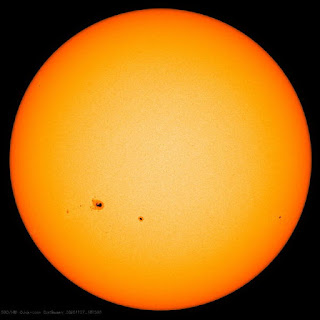 Solar Cycle 25’s Fast Progress
Solar Cycle 25’s Fast Progress
Blog readers may remember my previous blog discussing a more optimistic prognosis for the just-starting solar Cycle 25. It described the then recently-published scientific paper whose conclusion was rather startling:
"... we deduce that Sunspot Cycle 25 could have a magnitude that rivals the top few since records began."
The scientific paper described the exact opposite of any and all predictions that I have read or have seen referenced, and at the time of publication, was surely a bold and risky claim for the paper's authors. (1)
An over-simplification of the methodologies used to develop their prediction describes the study of the complex relationship involving the Sun's 22-year (Hale) magnetic cycle, the end points of adjoining cycles called 'terminations' and sunspot production, to predict the eventual strength of the new cycle.
The end of the cycle or ‘terminator’ event plays a significant role in the new cycle’s progress, as the shorter the separation between adjoining terminators, the stronger the next cycle will be. The possibilities of Cycle 25 being a truly strong one depends upon (according to the paper) a terminator event occuring sometime before the end of 2020.
Although there has been no official announcement as of yet, it appears that the termination may be presently occuring. Again following the paper, the termination event will produce a sudden and marked upturn in the growth of solar activity and will in fact, switch on suddenly within one solar rotation. As startling as this sounds, it appears to be exactly what is happening on the Sun right now.
 |
| courtesy: nasa.gov |
Just one week ago, the Sun’s solar flux stood at ~79 sfu (Solar Flux Units) but has climbed rapidly to 110. With several active sunspot regions on the earth-facing side of the Sun and several actively flaring groups about to rotate into view on the backside, it seems as if this sudden growth may be sustainable.
What is particularly encouraging is the activity level of the earth-side spots as well as the ones coming around, with several C and B-class flares continuing to push the flux higher.
Although it will likely slow and subside, a key indicator of future strength will be the time that it takes to recover and climb again.
Another interesting gauge of a new cycle’s possible future strength is the number of months needed to reach an average monthly SFI of ‘90’. Strong cycles tend to climb early and rapidly, in order to reach their lofty heights.
The strongest cycle on record was Cycle 19, the grandaddy of them all.
 |
| courtesy: http://www.solen.info/solar/ |
Compared to anything before or after, it was a magnificent monster of a cycle for ham radio. Cycle 19 reached the magic SFI 90 value in only 18 months ... Cycle 25 has reached this same point in just 12 months! If this is indeed an accurate marker for cycle strength, and there is no reason to believe otherwise, then maybe we should all hold onto our hats.
We’ve been told for several years by those who know these things, that Cycle 25 would likely be a repeat of the poorly-performing Cycle 24, or even weaker. I think one thing that can now be reasonably surmised is that this isn't another Cycle 24! We should know shortly, if Cycle 25 is the real thing or not, once the termination event has been confirmed.
In the meantime, enjoy the wide open strong signal opportunities now playing on 10m ... the band is back once again and in fine form ... way earlier than anyone ever expected!
(1) Scott W. McIntosh (1), Sandra C. Chapman (2), Robert J. Leamon (3,4), Ricky Egeland (1), and Nicholas W. Watkins (2,5,6)
1 National Center for Atmospheric Research, P.O. Box 3000, Boulder, CO 80307, USA.
2 Centre for Fusion, Space and Astrophysics, University of Warwick, Coventry CV4 7AL, UK
3 University of Maryland, Department of Astronomy, College Park, MD 20742, USA.
4 NASA Goddard Space Flight Center, Code 672, Greenbelt, MD 20771, USA.
5 Centre for the Analysis of Time Series, London School of Economics and Political Science, London WC2A 2AZ, UK
6 School of Engineering and Innovation, STEM Faculty, The Open University, Milton Keynes, UK














Hi Steve,
If you or other readers want to know more details about why Dr. McIntosh’s team make this startling prediction, listen to my feature interview of him in the ICQ Podcast episode at:
https://www.icqpodcast.com/download-the-show/2020/8/30/icq-podcast-episode-332-exciting-bumper-new-solar-cycle.
73,
Frank
K4FMH
Hi Steve, yes, this certainly is a fast start. Thanks for your careful summaries. 73
My pleasure Elwood. Feels good to be watching the Sun come to life again. Sure hope it continues to produce lots of spots!
This is certainly hopeful. The world, including that of hamming, certainly needs some good news. Sometimes reading predictions and watching the numbers to guess what the sun would do I felt like a Roman seer might have, trying to read the future in a sheep’s liver or by the flight of birds. But maybe this time the radio gods are smiling on us.
Steve, thanks for giving me a good start to my Sunday morning. Watching the SFI this week, I’ve started to think it’s maybe not all doom and gloom this year, and your post just confirms this optimism. We just need to tweak our antenna systems now and wait for the action!
73, Colin
GM4JPZ
Yes, it’s very exciting to see where this all goes. Not only is Cycle 25 six months ahead of Cycle 19 for SFU but it’s six months ahead for sunspot numbers as well!
Here is a recent video from the chief solar scientist re the above paper. You can readily see how the team has come to the final prediction that this cycle will likely be huge. Look at their evidence… it seems so obvious. Interestingly, they were not looking at predicting the strength of this cycle but were studying the 22-year magnetic Hale Cycle, the real driving force of the Sun…but they noted the obvious relationship between terminator events (the start of a new 22 year cycle and the end of the old one). Hind modelling indicated the relationship and conclusions re cycle strength were real.
https://m.youtube.com/watch?feature=youtu.be&v=lRNJPkQPo_g
Many thanks for the link and excellent summary/comment.